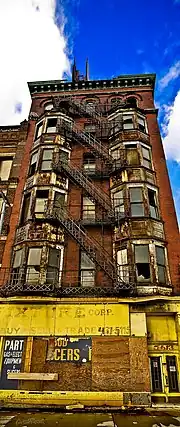
A condemned property or a condemned building is a property or building that local (usually municipal) authorities have closed, seized, or placed restrictions on for various reasons, including public safety and public health, in accordance with local ordinance.
Characteristics
In most cities, condemned properties are usually buildings that are extremely dilapidated, damaged or deteriorated, so that they are likely to collapse or become an unattractive nuisance or urban blight. Such buildings may also be fire hazards or severe health hazards, and may be infested with rodents or vermin and lacking in basic facilities such as water, electricity, and heat.[1] Sometimes, such properties can be associated with illegal drug activity.[2] They are typically in violation of other code requirements that make it dangerous to occupants or the public.[3] Food storage premises within the municipality that are deemed non-rat-proof have also historically been candidates for condemnation.[4] In conjunction with condemnation, local authorities may prohibit or restrict occupancy, prohibit habitation, seize the property, prohibit certain actions such as preparation of food or transaction of business, mandate remedial actions, or raze the structure.[3]
History
Municipalities of Cumberland, Maryland, were given the power to condemn and seize insanitary buildings in 1915.[5]
In 2000, a Swedish researcher reports a case study in which after many years of puzzlement and contention, a building that housed government employees was condemned for sick building syndrome; that is, something indeterminate about the building itself made the occupants ill.[6]
References
- ↑ "Condemnation, Unfit for Human Habitation". City of Saint Paul, Minnesota. 20 October 2015.
- ↑ "RCW 35.80A.010 Condemnation of blighted property". Washington State Legislature.
- 1 2 "Unsafe Buildings Information". New York City Department of Buildings. January 2021.
- ↑ United States, Public Health Service (1915). Annual Report of the Surgeon General of the Public Health Service of the United States. Washington: U.S. Government Printing Office.
- ↑ United States, Public Health Service (1915). Public Health Reports (Volume 30 Part 1 January - June 1915 ed.). Washington: Government Printing Office. p. 517.
- ↑ Thorn, A. (2000). "Emergence and preservation of a chronically sick building". Journal of Epidemiology & Community Health. 54 (7): 552–556. doi:10.1136/jech.54.7.552. PMC 1731714. PMID 10846199.